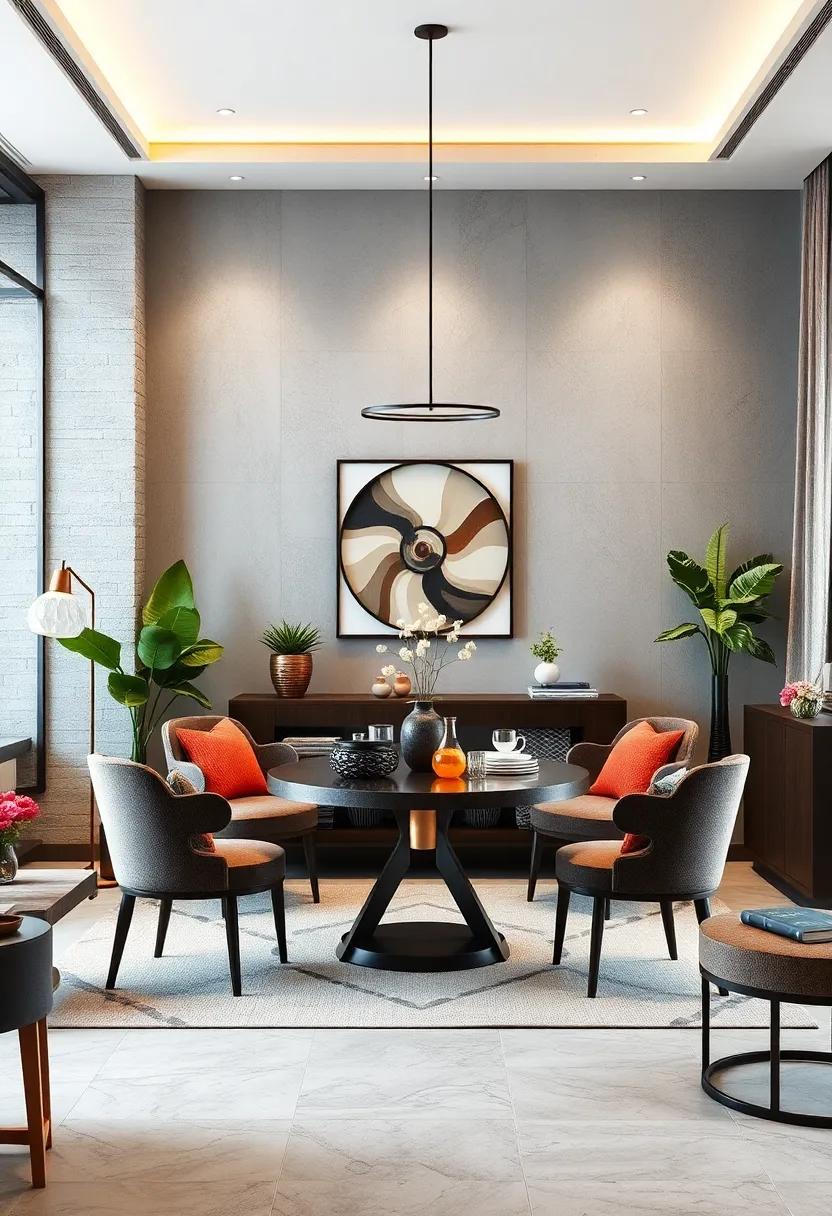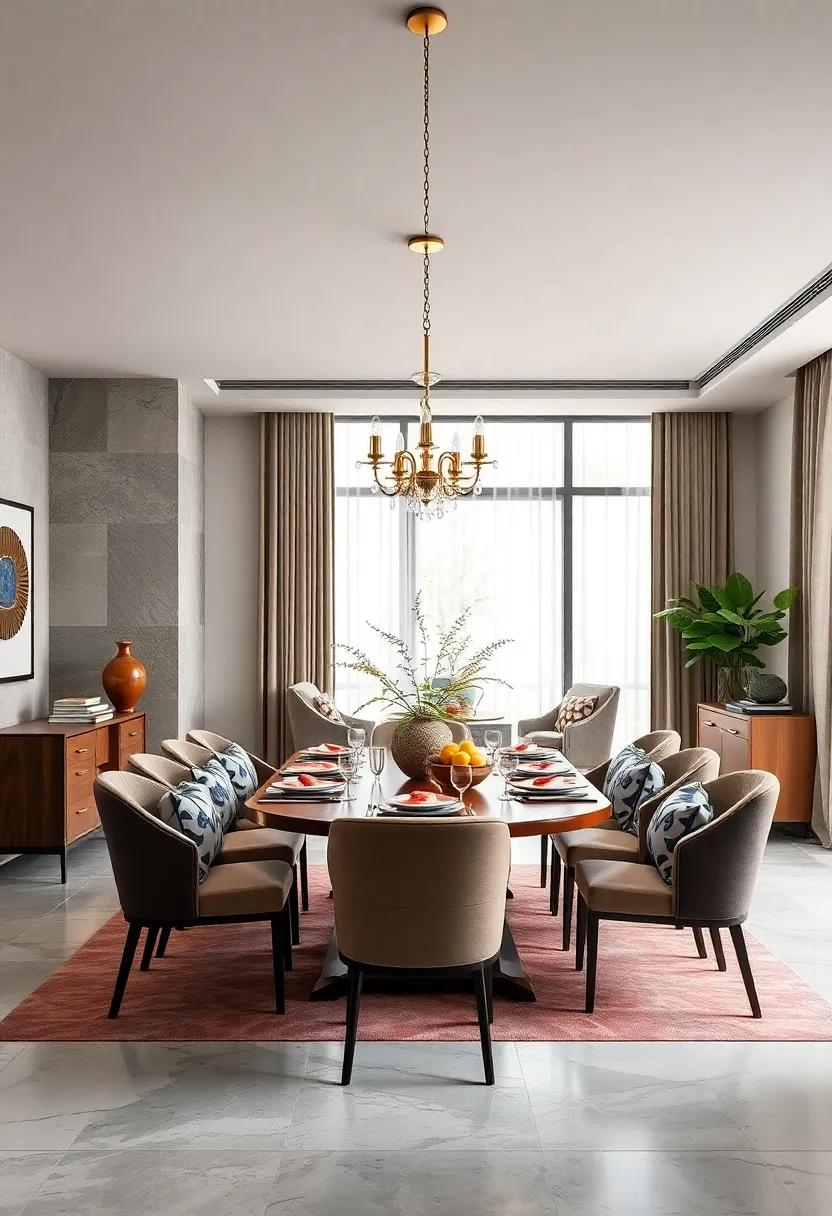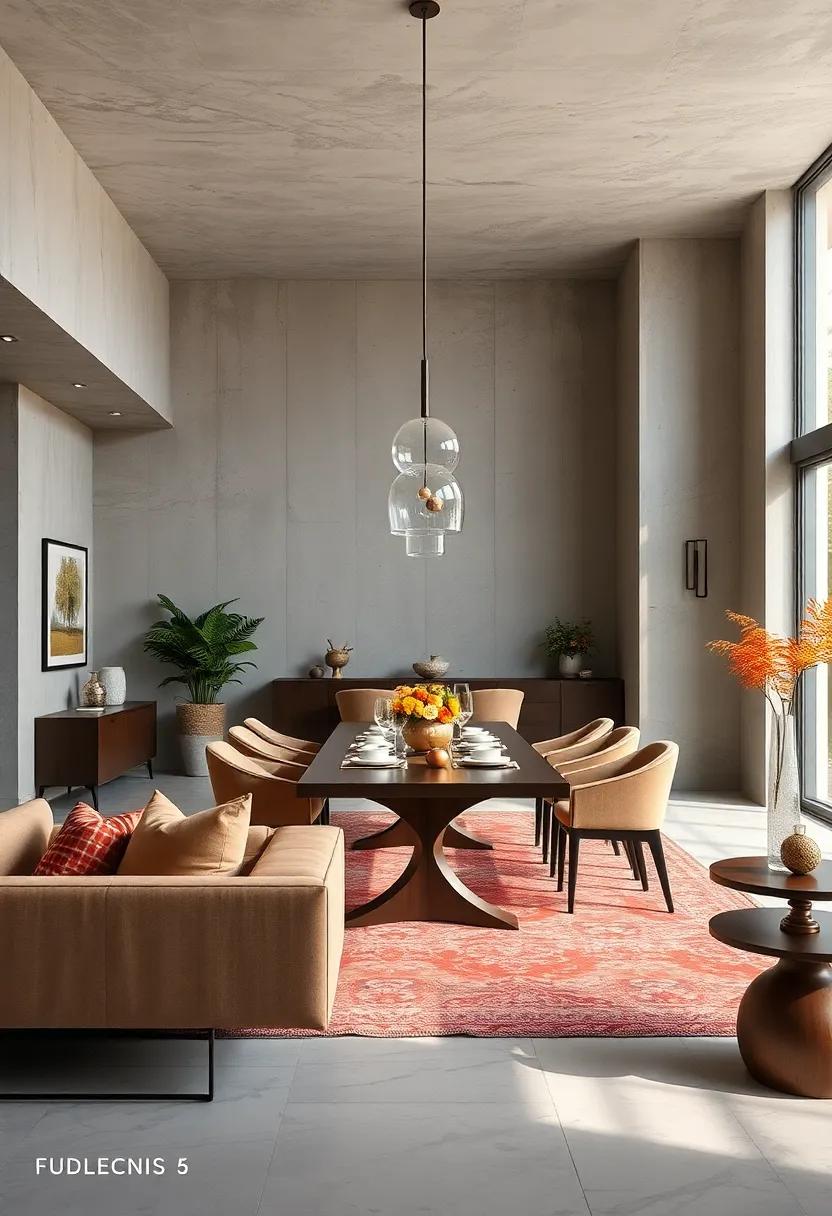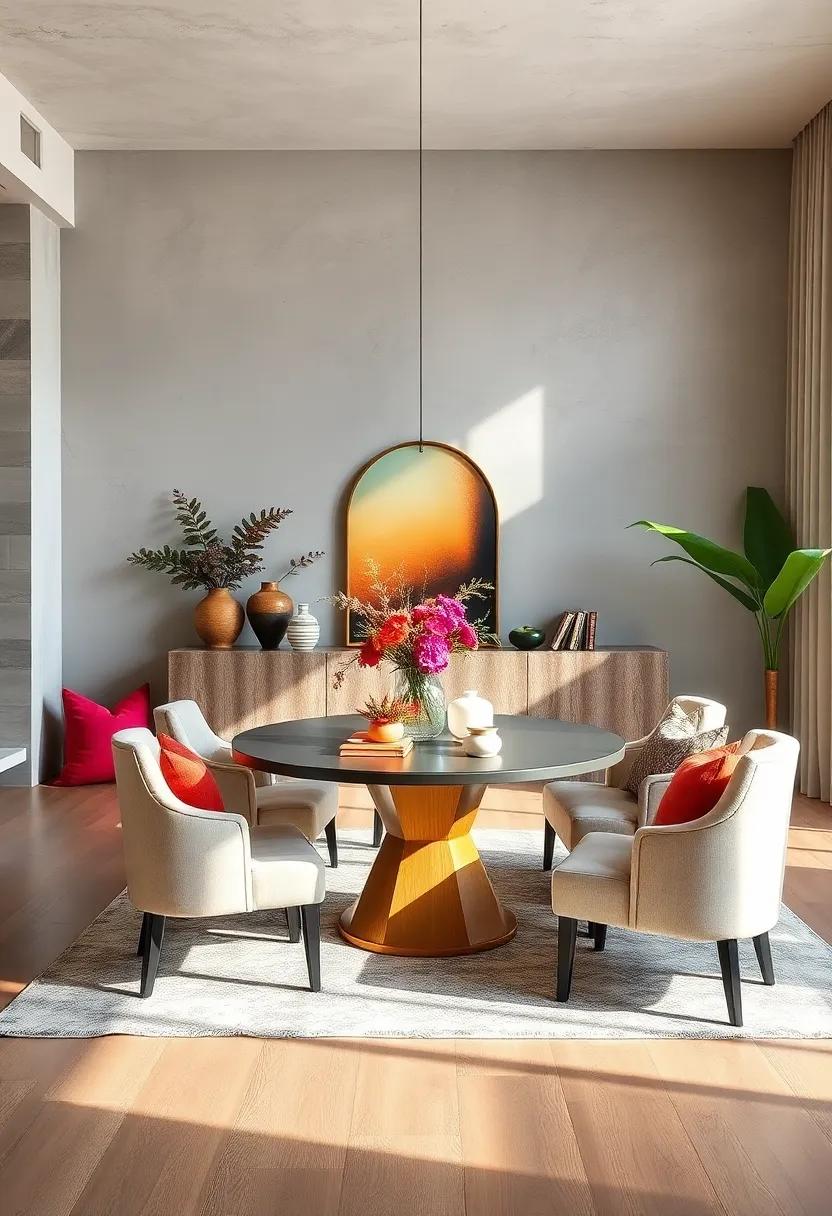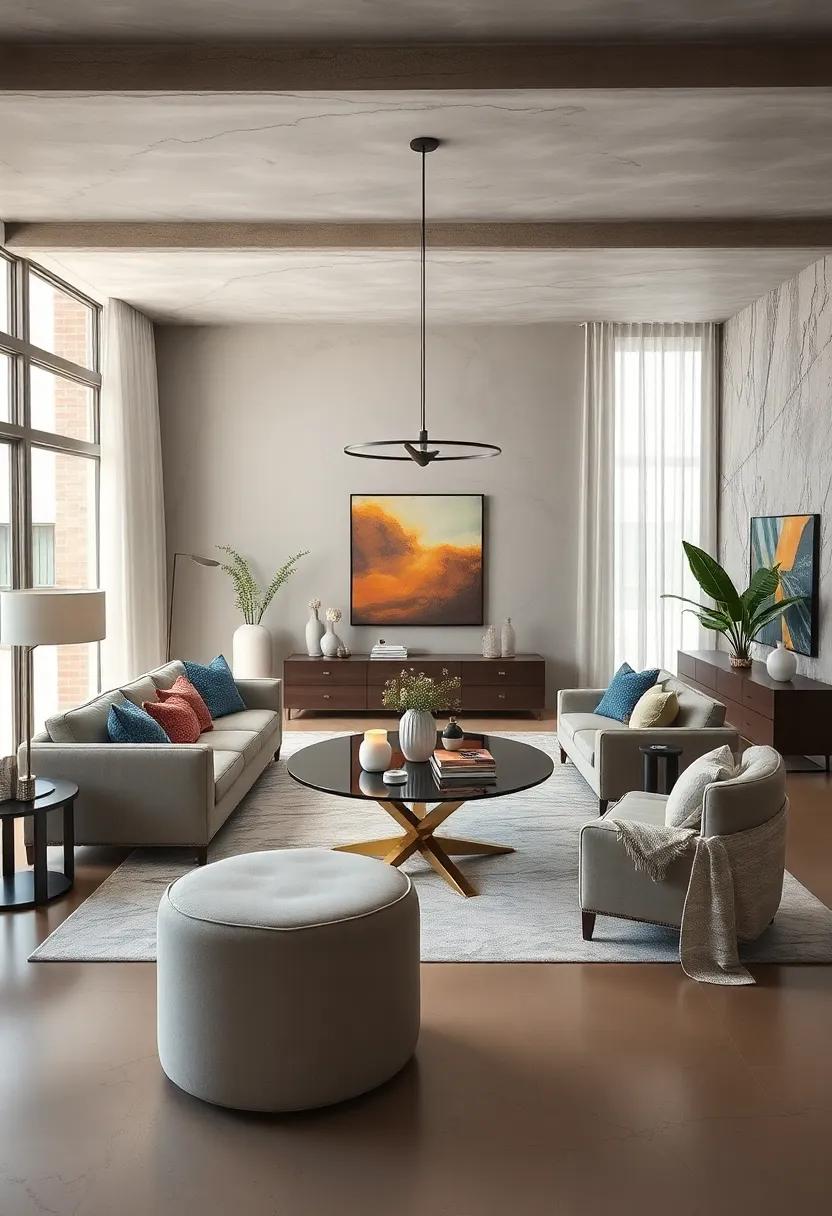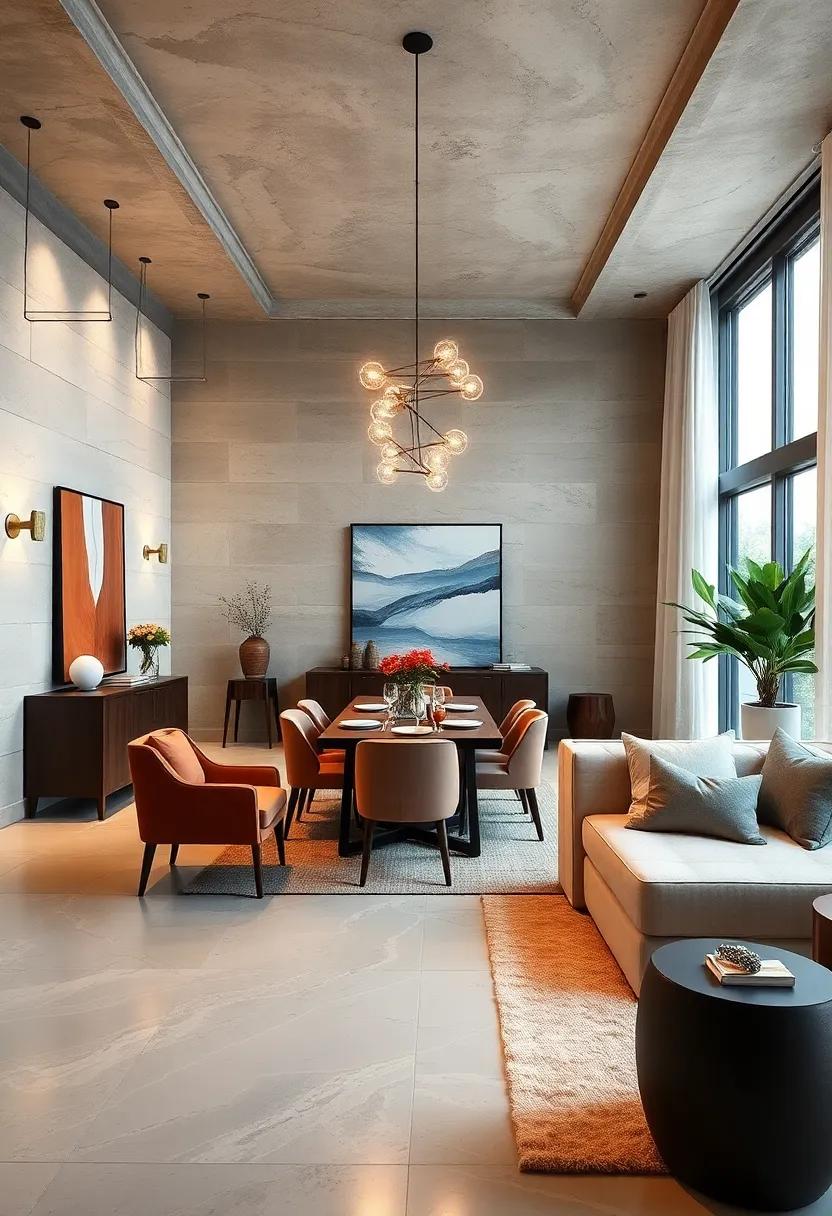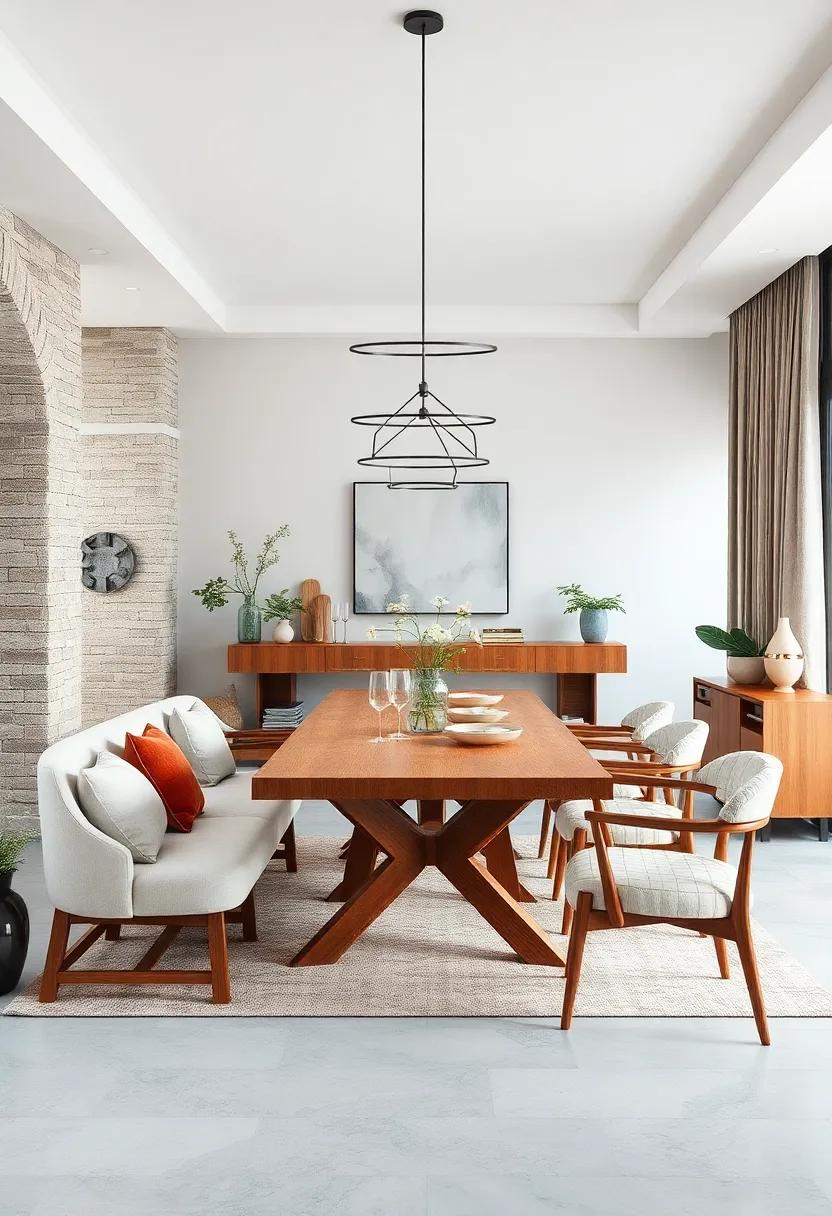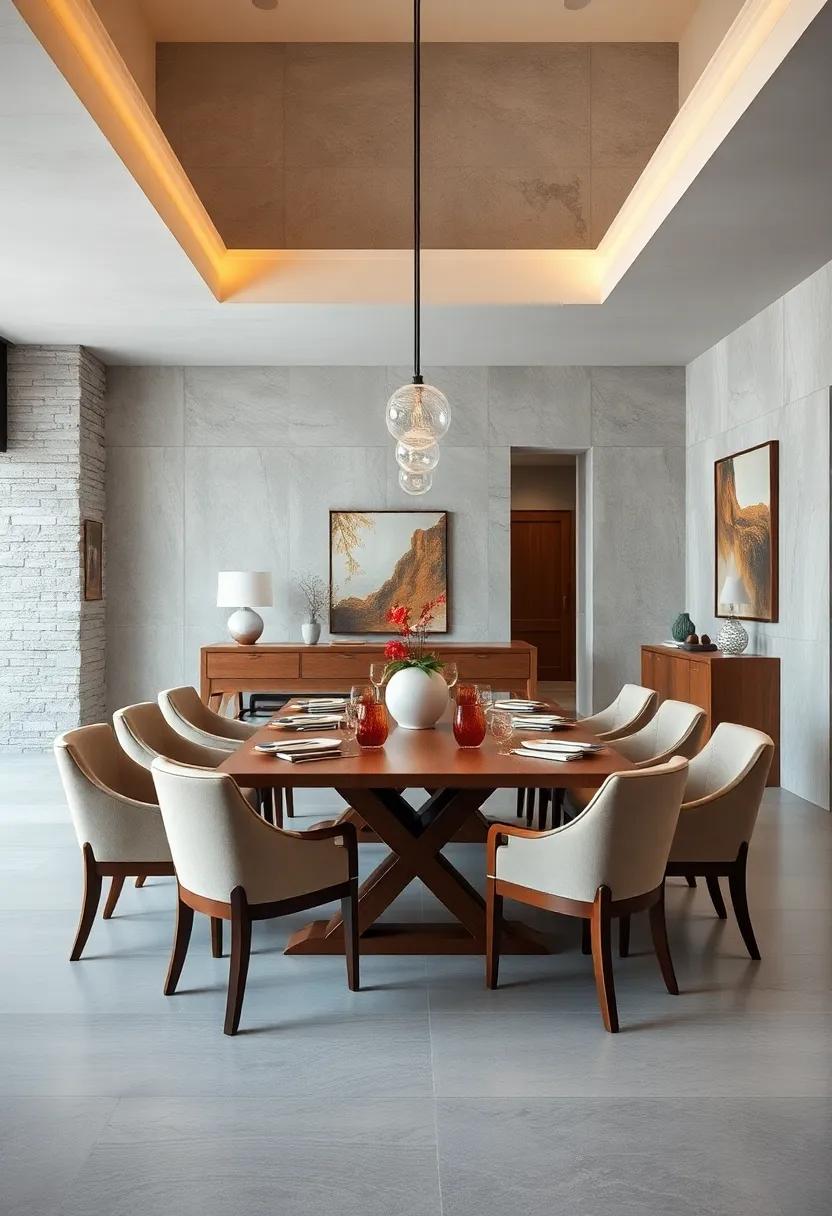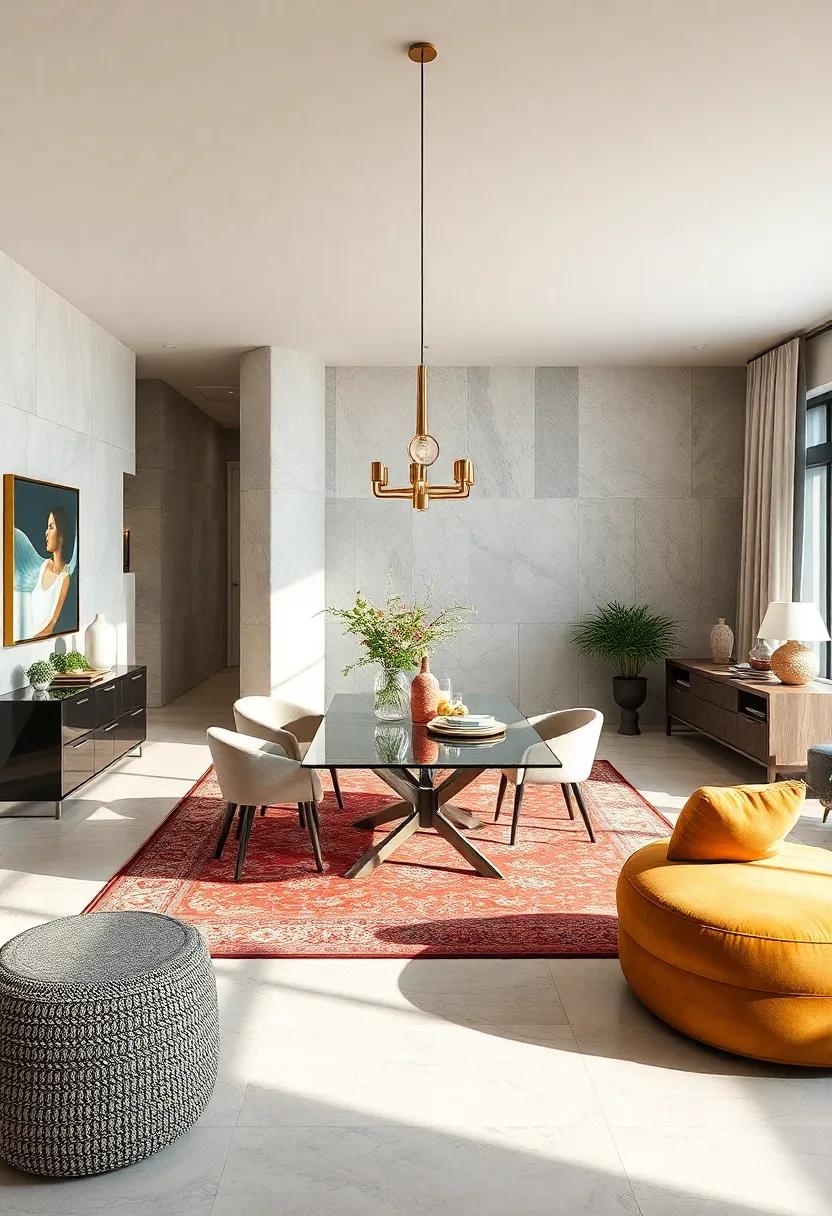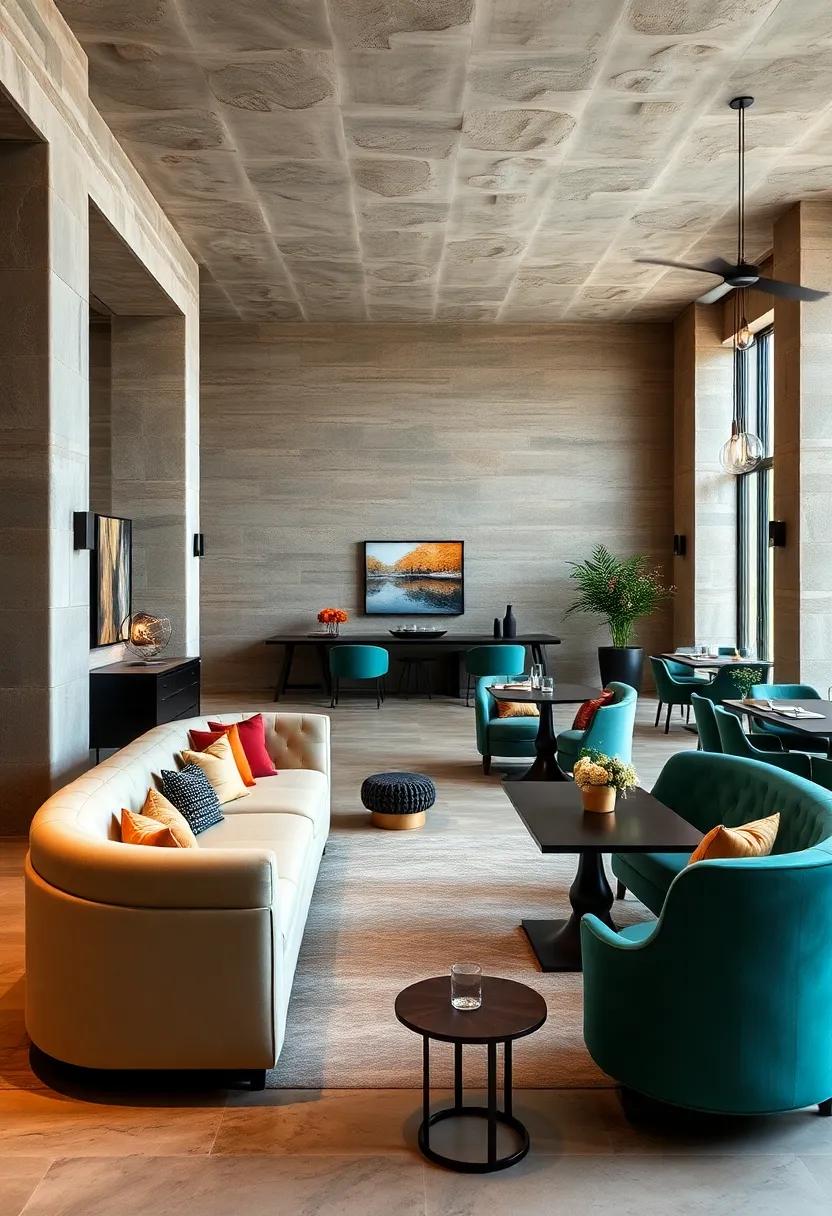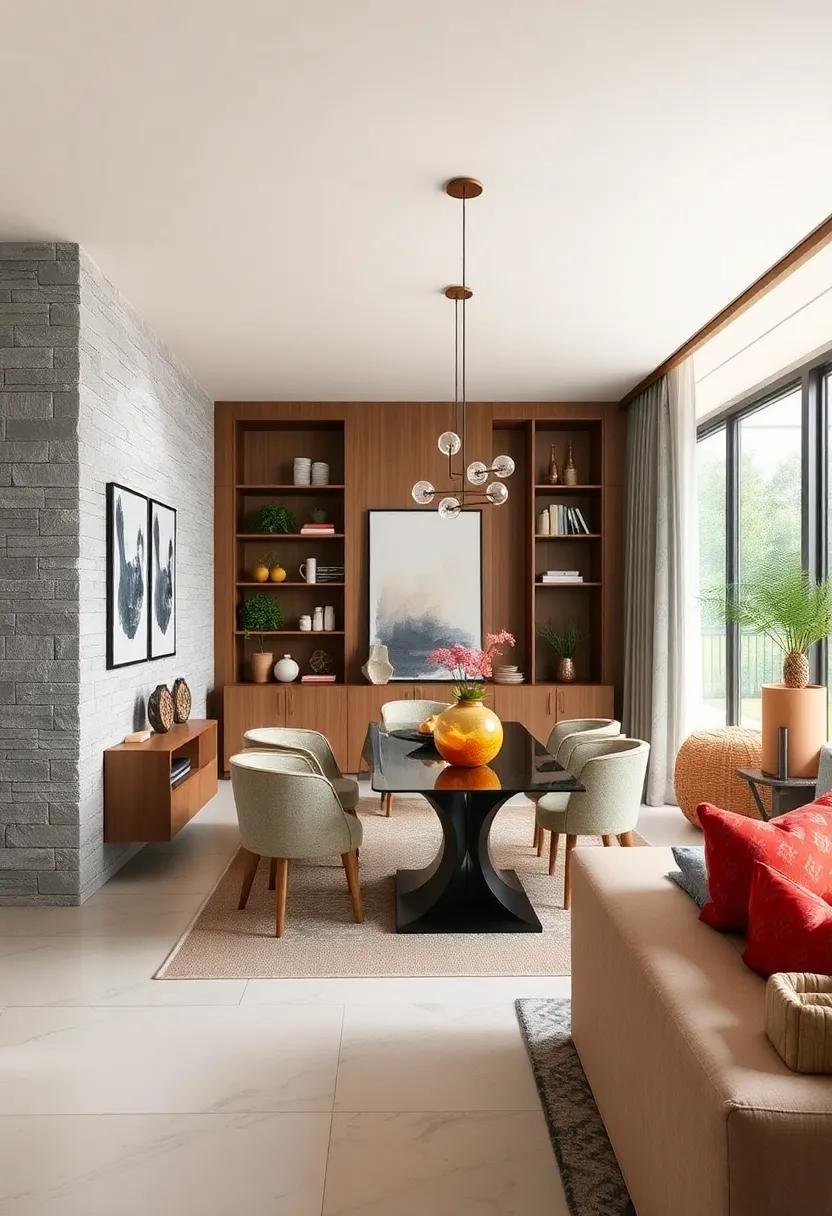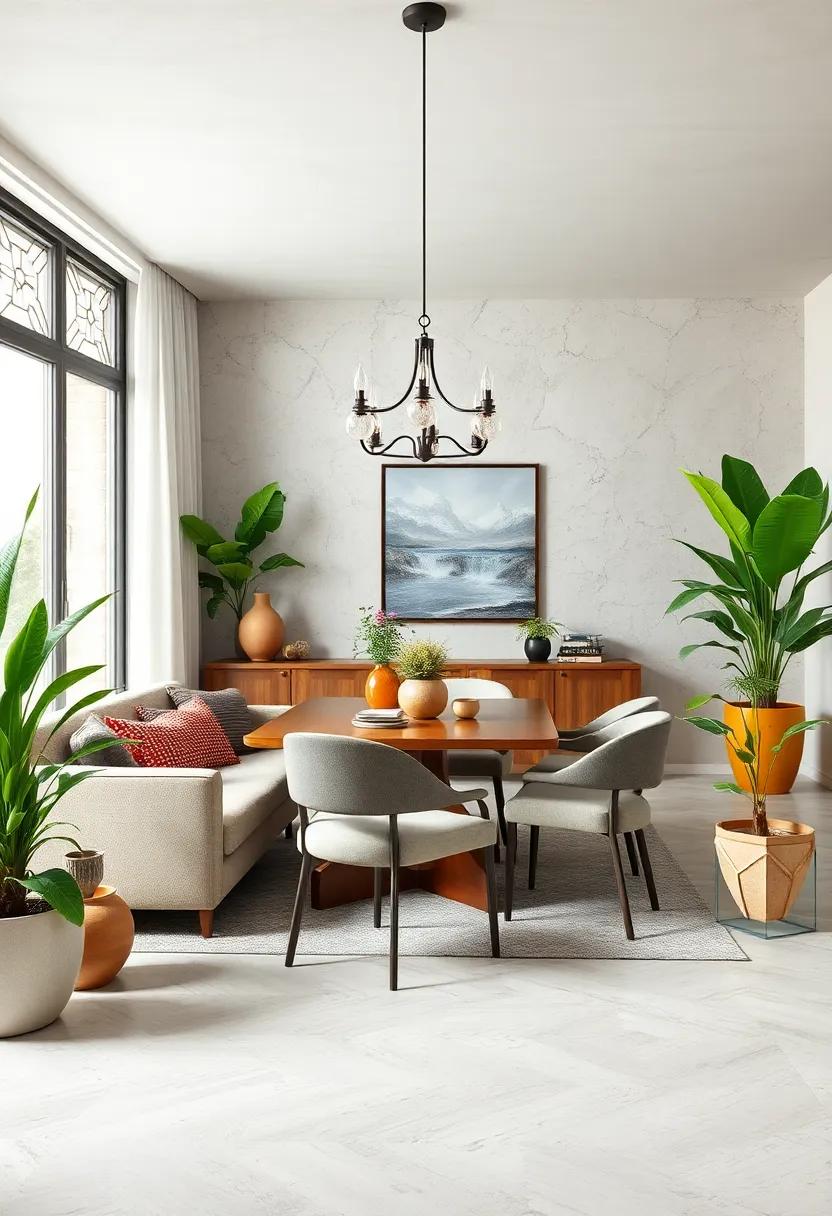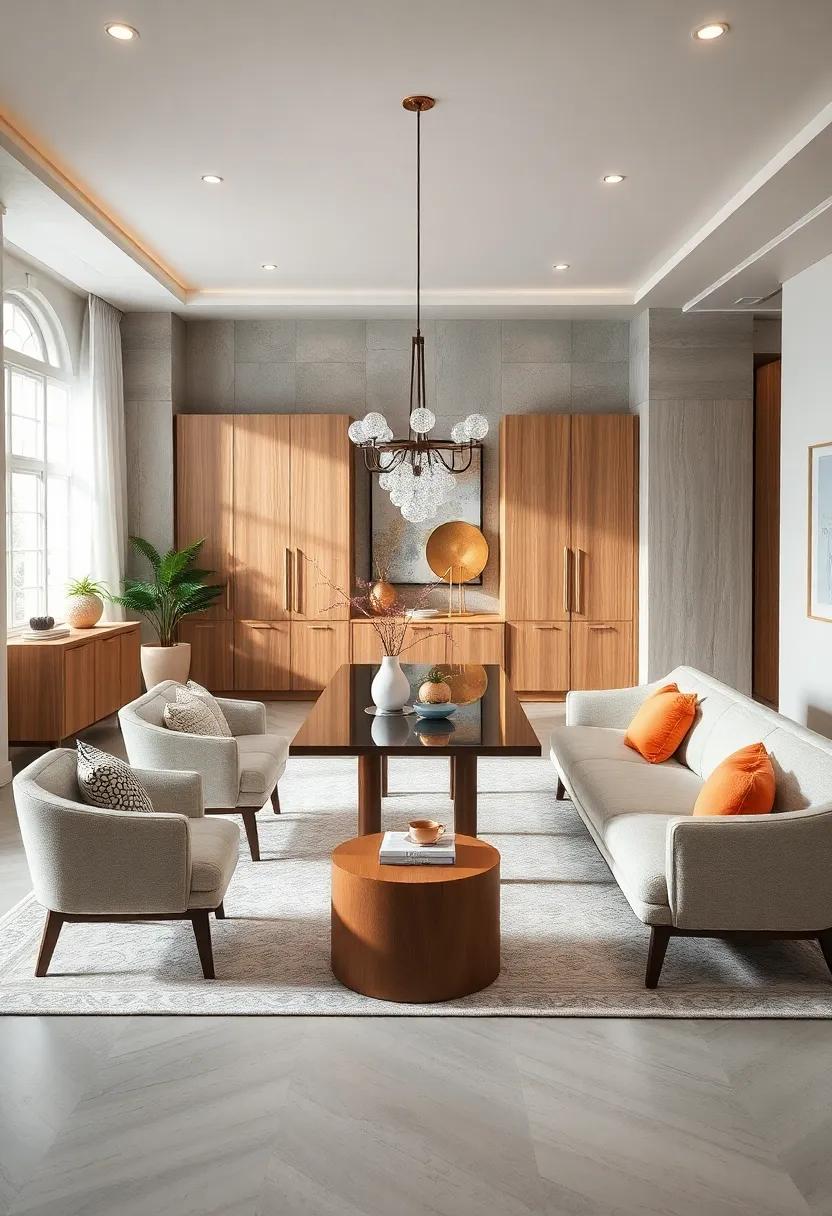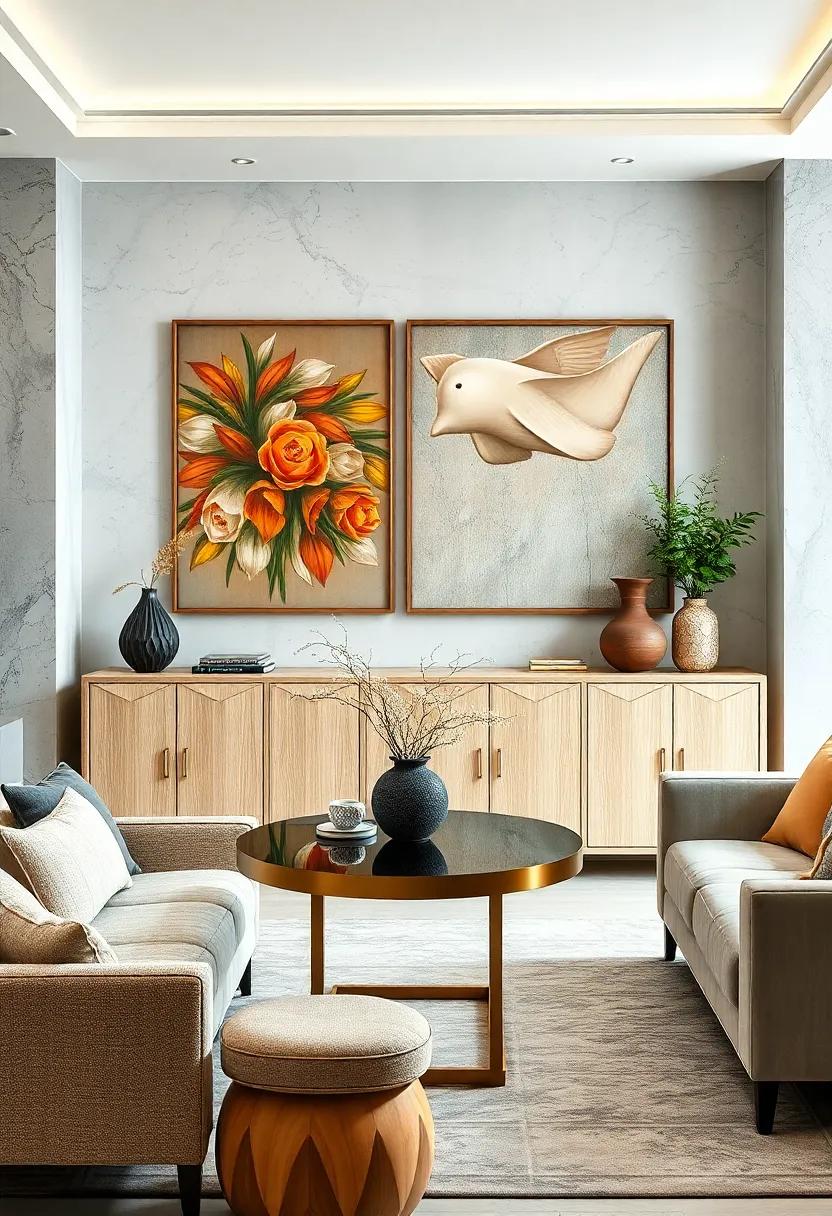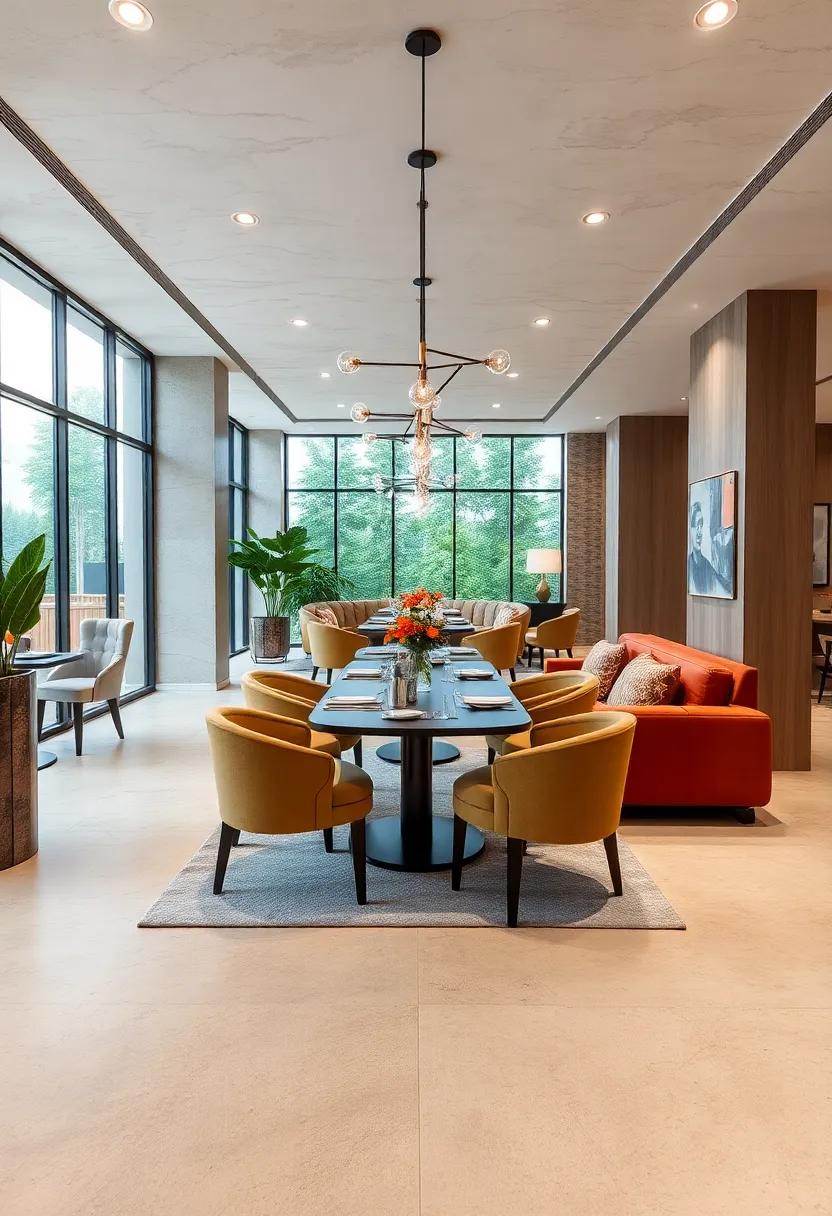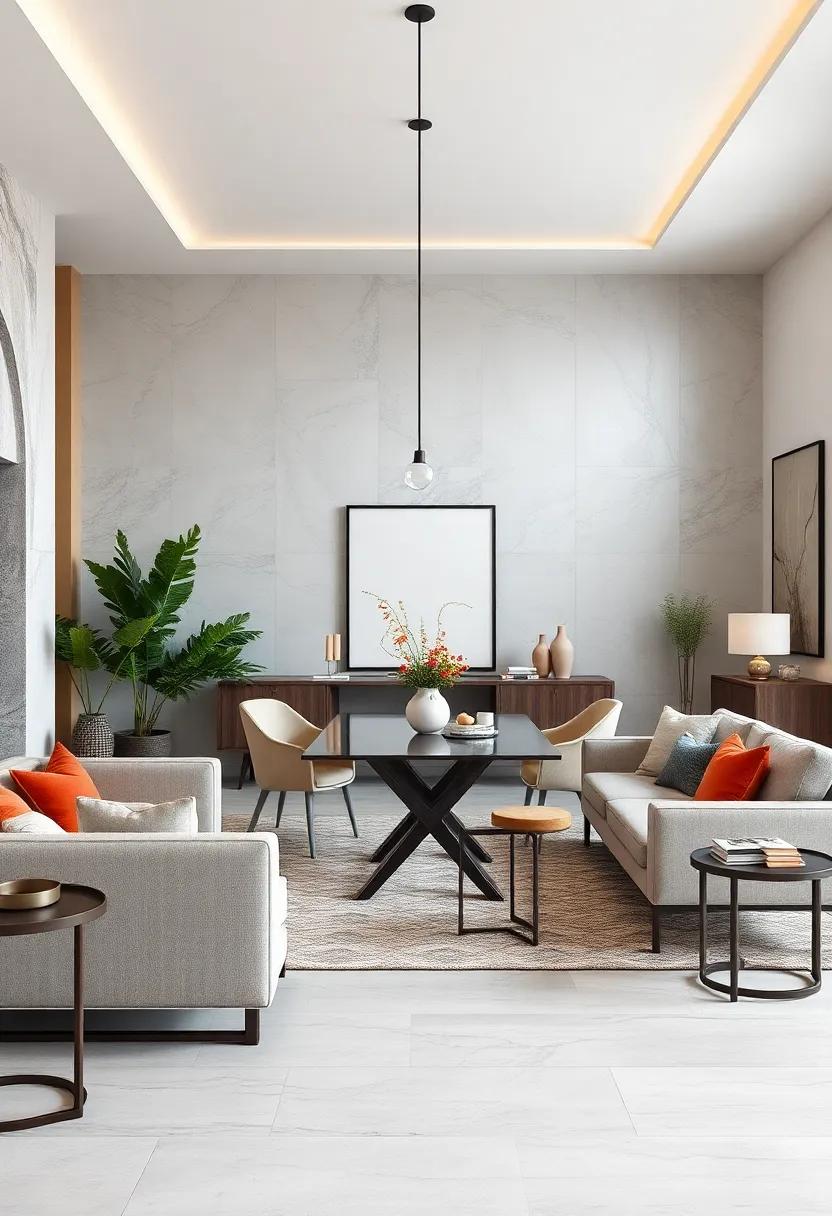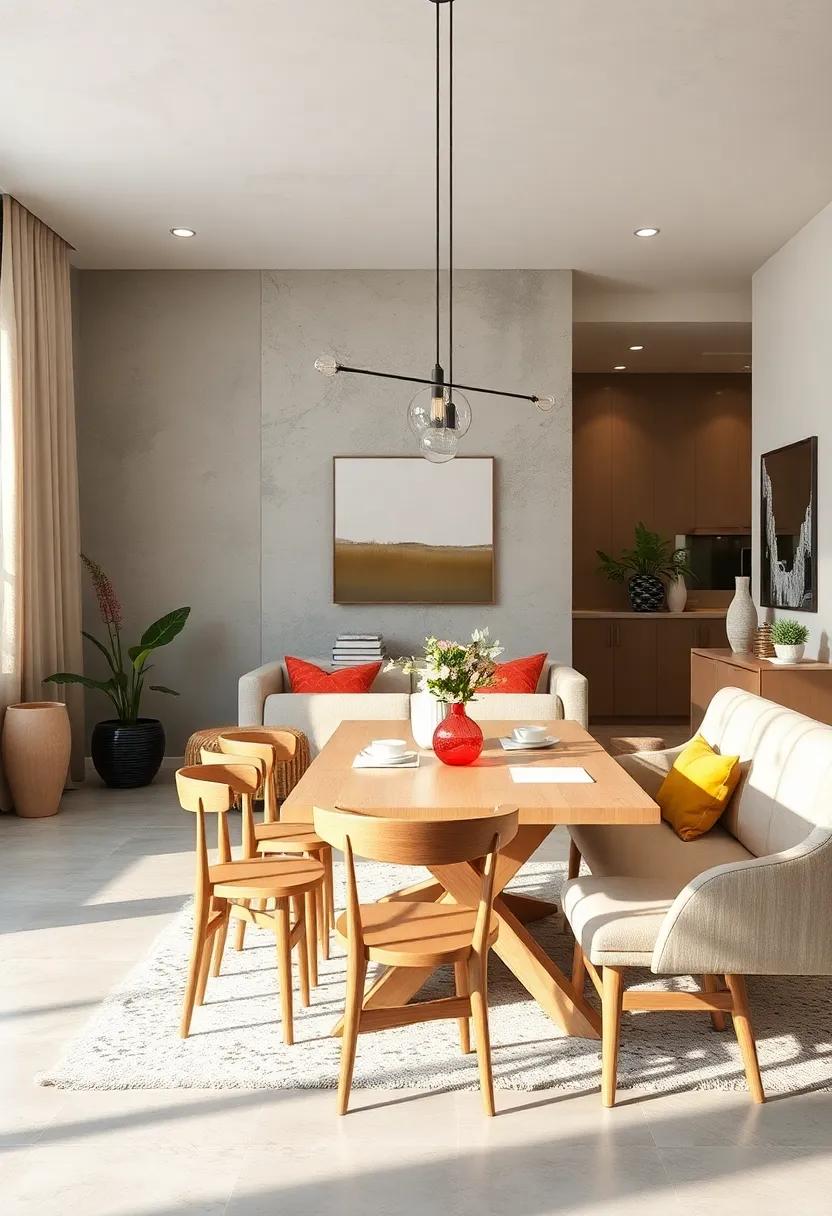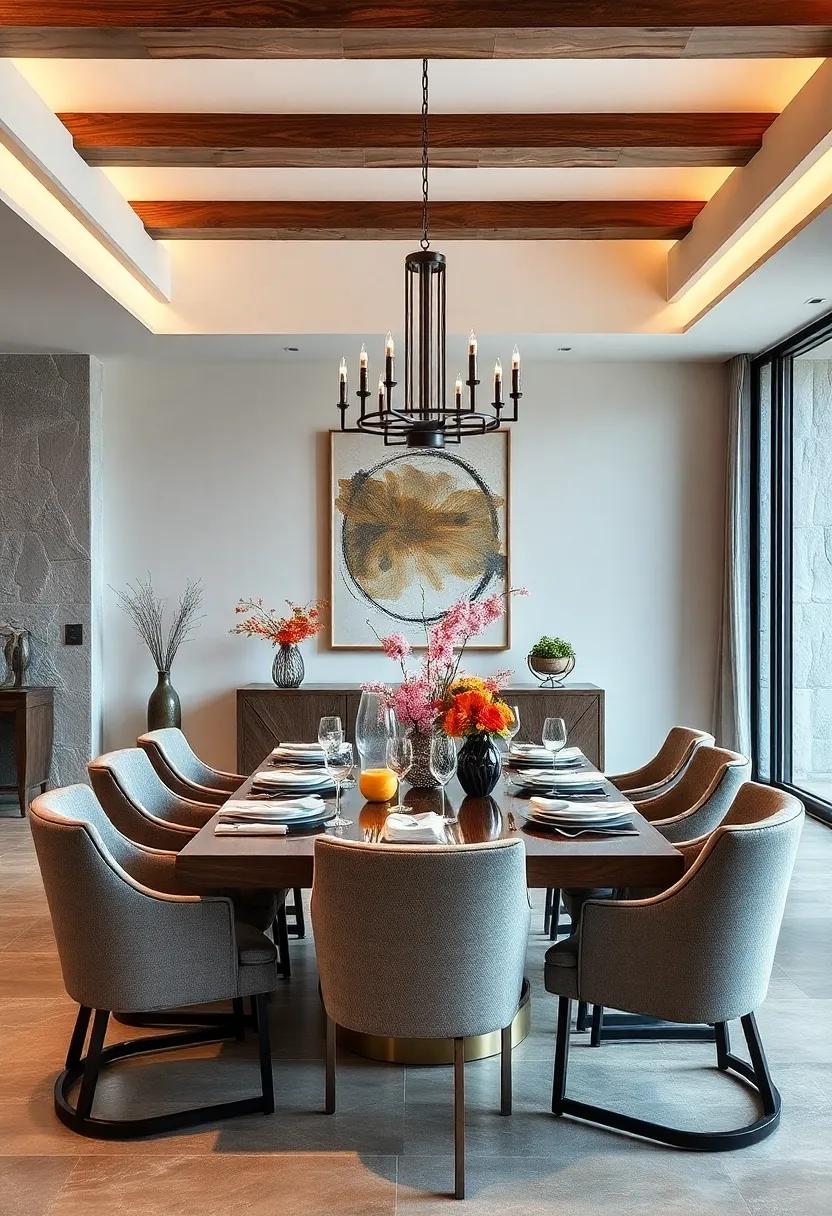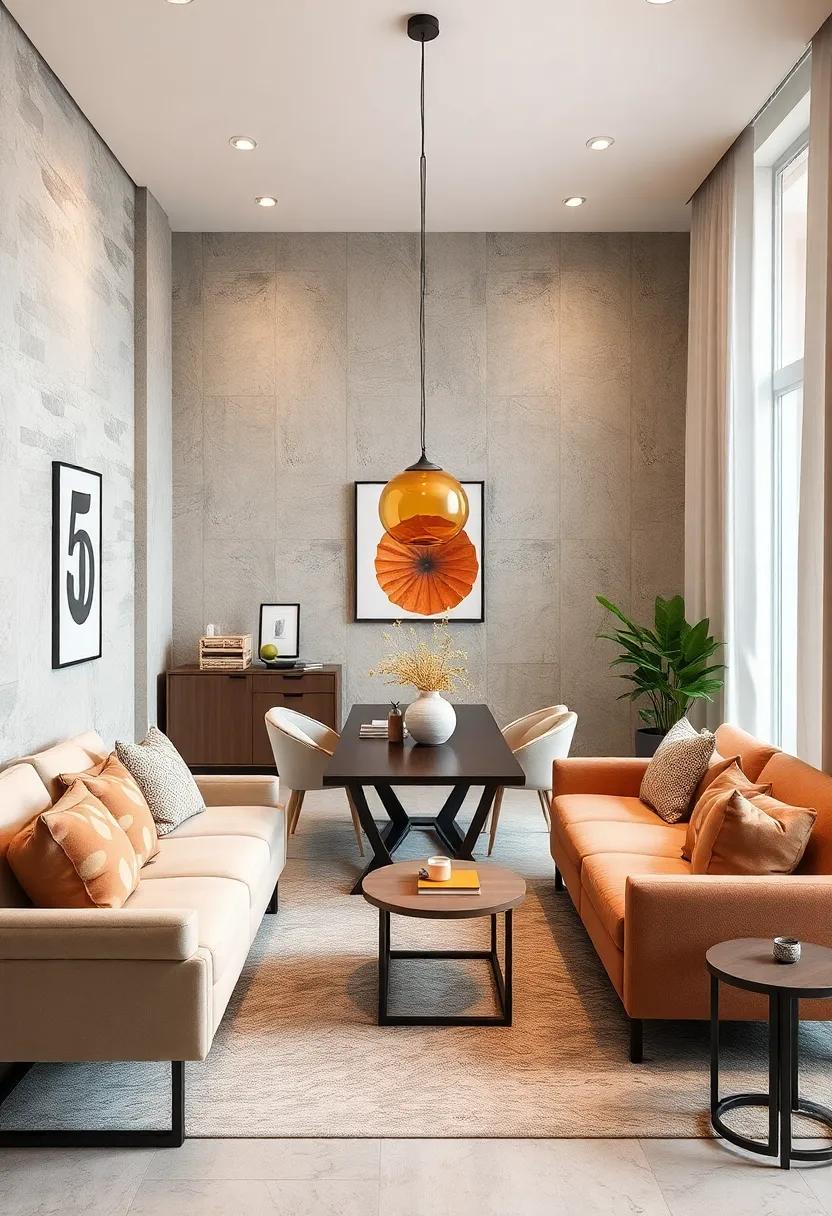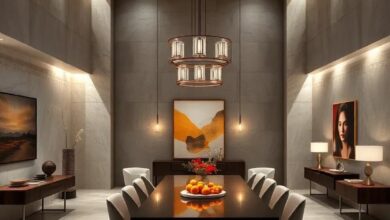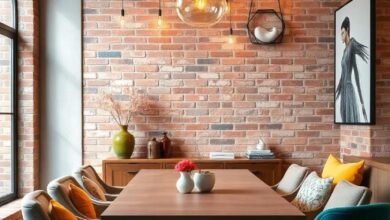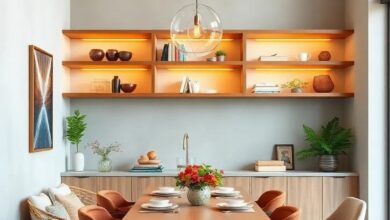Crafting Harmony: Smart Dining Room Furniture Arrangements for Every Space
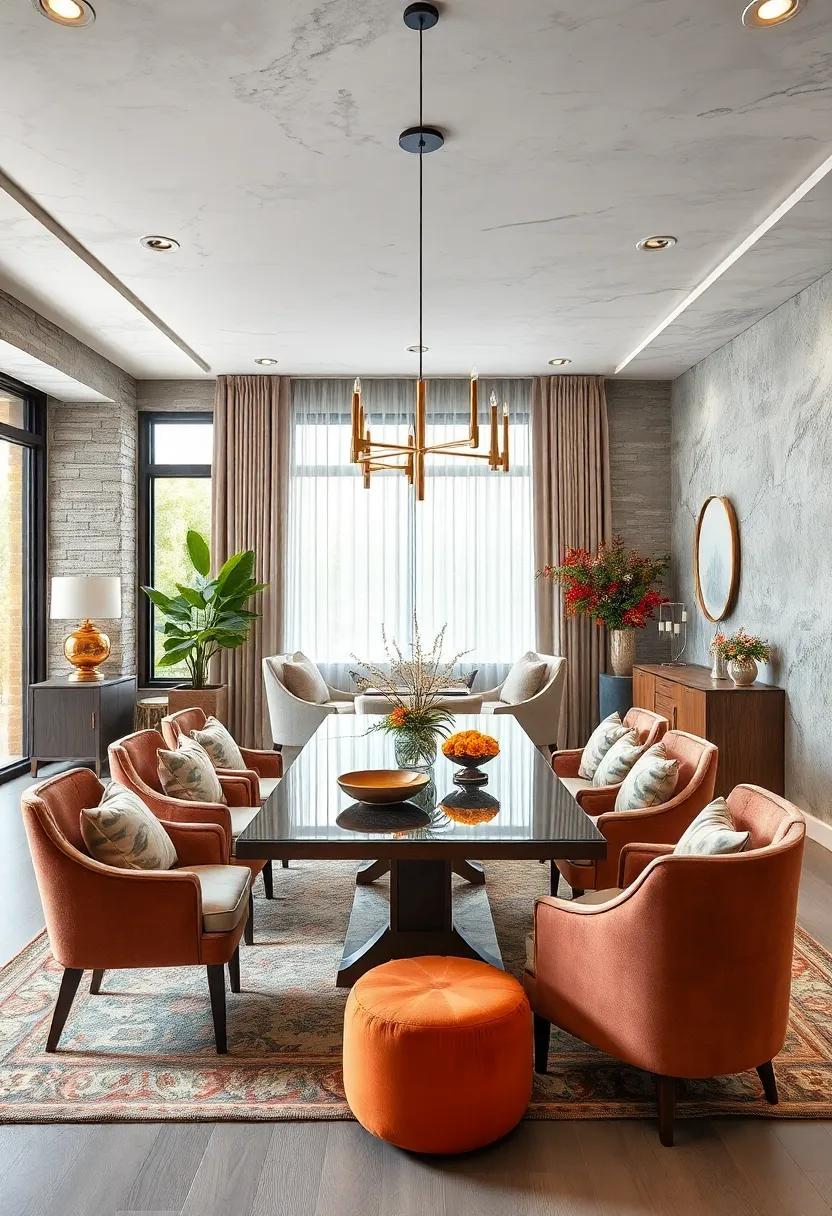
In the modern home, the dining room is no longer just a place to eat-it’s a stage where moments of connection, conversation, and celebration unfold. Crafting harmony within this essential space requires more than just choosing beautiful furniture; it demands thoughtful arrangement tailored to the rhythm of every room. Whether you have a cozy nook or a sprawling area, smart dining room furniture layouts can transform any space into a functional and inviting haven. This article explores creative strategies for designing dining room setups that balance style, comfort, and flow, ensuring that every meal feels beautifully orchestrated.
Optimal Round Table Placements Encouraging Intimate Conversations in Compact Dining Spaces
Choosing the right round table size and positioning it thoughtfully can transform a compact dining room into a cozy nook where every guest feels included. Opt for tables with diameters between 36 to 48 inches to maintain a balance between functionality and intimacy. Place the table centrally with enough clearance-at least 30 inches around-to allow comfortable movement without overcrowding. Incorporating a pedestal base can enhance legroom, encouraging relaxed postures and longer, more engaging conversations.
To further enhance the experience, consider pairing your round table with chairs that have open, slender frames, creating an illusion of space and lightness. Complement the setup with soft, warm lighting directly above the table, such as a pendant lamp with dimmable features, which draws focus inward and sets a convivial mood. For a quick visual, here’s a simple guide to round table sizing and seat capacity:
| Table Diameter | Seats Comfortably |
|---|---|
| 36 inches | 4 people |
| 42 inches | 4-5 people |
| 48 inches | 5-6 people |
Balancing Color and Texture in Smart Dining Room Layouts for Visual Harmony
When designing a dining room, achieving a cohesive visual flow hinges on the artful integration of color and texture. Selecting colors that complement rather than compete helps create a tranquil ambiance where every piece feels intentional. For instance, pairing muted earth tones with bursts of deeper hues injects depth without overwhelming the senses. Meanwhile, mixing textures-like a velvet upholstered chair alongside a sleek wooden table-adds tactile interest that invites guests to linger and engage. Balance is achieved through thoughtful layering:
- Match warm wood grains with cool metal finishes for contrast
- Combine matte and glossy surfaces to create dynamic reflections
- Use soft textiles like rugs and curtains to soften harder elements
Strategically placing these elements enhances the room’s rhythm, making the space feel harmonious rather than visually fragmented. One helpful approach is to refer to a simplified palette and texture matrix, ensuring every choice aligns intentionally:
| Texture | Suitable Finishes | Complementary Colors |
|---|---|---|
| Smooth | Polished stone, glass, lacquer | Soft pastels, cool blues |
| Textured | Woven fabrics, reclaimed wood | Warm neutrals, earthy greens |
| Metallic | Brushed brass, matte black iron | Deep charcoals, gold accents |
Visualizing Open Plan Dining Areas with Seamless Transitions and Cohesive Furniture Choices
Open plan dining areas thrive on the delicate balance between flow and function, where each piece of furniture plays a pivotal role in maintaining visual continuity. Opt for furnishings that echo the materials and tones used in adjoining spaces, such as a wooden dining table that complements the living room’s coffee table or sideboard. This intentional mirroring not only creates a seamless transition but also anchors the dining area as a natural extension of your home’s overall design. Integrating rugs with subtle patterns can further define the dining space without creating harsh boundaries, allowing the eye to wander freely and appreciate the cohesion.
Consider the power of multi-functional furniture and smart layouts to enhance versatility without compromising style. A bench seat tucked under a sleek table or chairs with slim profiles can reduce visual clutter and promote openness. To stimulate harmony, pay attention to the shapes and heights, blending round and rectangular forms for dynamic yet balanced appeal. Below is a simple guide to pairing furniture choices that guarantee smooth transitions:
| Furniture Element | Ideal Pairings | Visual Benefit |
|---|---|---|
| Dining Table | Wood or glass matching living room accents | Unifies materials, enhancing flow |
| Seating | Mix of chairs & benches with complementary fabrics | Varied texture without breaking cohesion |
| Lighting | Harmonious pendant styles echoing adjacent fixtures | Cohesive ambiance across zones |
Maximizing Natural Light Through Strategic Mirror and Furniture Positioning in Dining Rooms
Incorporating mirrors into your dining space isn’t just about decoration-it’s a clever tactic to amplify natural light and create an inviting ambiance. Placing a large, reflective mirror opposite or adjacent to windows can dramatically bounce sunlight around the room, making the environment feel brighter and more spacious. Consider mirrors with decorative frames that complement your dining furniture, adding both function and style. Additionally, positioning mirrors near light-colored walls enhances their effectiveness, allowing surfaces to reflect light rather than absorb it.
Furniture arrangement plays a pivotal role in maximizing this light enhancement. To keep the flow of daylight unimpeded, opt for low-profile or glass-topped tables and furnishings that allow light to pass through effortlessly. Avoid blocking windows with bulky, dark pieces; instead, use strategically placed seating and smaller accent tables to maintain openness. Here’s a quick guide for optimal mirror and furniture placement:
- Mirror placement: Opposite or adjacent to windows for maximum reflection
- Furniture choice: Light-colored, low-profile, or transparent materials
- Avoid: Heavy drapes and bulky furniture that block windows
| Element | Recommended Approach | Impact |
|---|---|---|
| Mirror type | Large and frameless or ornate to suit your style | Increases light dispersion, adds visual appeal |
| Table style | Glass or light wood with minimal bulk | Maintains light flow and openness |
| Seating | Benches or slim chairs placed strategically | Keeps space airy and uncluttered |
Cozy Corner Dining Nooks Featuring Space-Saving Benches and Artistic Wall Accents
Transforming a dining area into a serene retreat begins with the thoughtful integration of space-saving benches, which not only maximize seating but also infuse a sense of intimacy to the space. These benches can slide neatly under tables or double as storage units, keeping clutter at bay and maintaining a streamlined aesthetic. Complementing this setup with cushions or throws in neutral tones or bold patterns adds layers of comfort and style. By positioning these nooks near windows or corners, natural light emphasizes the warmth and inviting atmosphere without overwhelming the room’s design.
Artistic wall accents serve as the perfect finishing touch, turning dining spaces into personalized galleries. Consider grouping eclectic frames, geometric metal pieces, or handcrafted wooden art to create a lively focal point. Mixing textures and materials here can elevate the nook’s charm, making every meal feel like a curated experience. Below is a concise guide to selecting the best wall accents based on your room’s vibe:
| Style | Recommended Wall Accent | Effect |
|---|---|---|
| Modern Minimalist | Abstract Metal Sculptures | Creates sleek, dynamic focal points |
| Rustic Farmhouse | Reclaimed Wood Frames & Signs | Adds warmth and nostalgic charm |
| Bohemian Chic | Colorful Tapestries & Woven Art | Enhances vibrancy and texture |
| Classic Elegance | Ornate Mirrors & Framed Sketches | Promotes sophistication and light |
Arranging Multi-Functional Furniture Pieces to Adapt Seamlessly for Hosting and Daily Use
Designing a dining space that effortlessly transitions from everyday meals to lively gatherings requires a keen eye for versatility. By integrating multi-functional furniture pieces, you create a dynamic environment that adapts as needed without compromising style or comfort. Consider a dining table with extendable leaves that can smoothly expand when guests arrive, paired with stacking or folding chairs that tuck away to free up space when not in use. These adaptable selections not only optimize the room’s footprint but also encourage a clutter-free setting, allowing the space to breathe and flow with each occasion.
Maximizing functionality is further enhanced when complementing these core pieces with clever storage options that blend seamlessly into the room’s design. Buffets with sliding doors or compact cabinets equipped with hidden compartments offer a place to store dinnerware, linens, or games-keeping everything at hand without overcrowding surfaces. Here’s a simple overview of practical furniture setups to inspire your layout:
| Furniture Piece | Daily Use | Hosting Mode |
|---|---|---|
| Extendable Dining Table | Compact for everyday meals | Expands to seat 8+ guests |
| Stacking Folding Chairs | Stored away to maximize space | Extra seating ready instantly |
| Storage Buffet | Holds daily essentials & decor | Displays serving ware & beverages |
Incorporating Statement Lighting Fixtures for Focused Ambiance in Dining Room Settings
Transforming your dining room into a sanctuary of style and function begins with the artful use of bold lighting fixtures. These centerpiece illuminators don’t just brighten the room; they cast a curated glow that syntonizes every dining moment with atmosphere and intent. Whether it’s a sleek pendant lamp with geometric lines or an intricate chandelier boasting vintage charm, strategically placed lighting creates a visual anchor that naturally draws focus to your dining table, fostering an intimate and inviting vibe. By layering light, you subtly guide guests and family members alike, emphasizing textures, colors, and materials that harmoniously coexist within your furniture arrangement.
When selecting statement lighting, consider these key elements for optimal ambiance:
- Height and scale: Choose fixtures that complement the ceiling height and table dimensions, ensuring balance without overwhelming the space.
- Light temperature: Opt for warm hues to evoke comfort during dinners, or cooler tones when clarity and alertness are desired.
- Dimmability: The ability to adjust brightness levels allows for dynamic mood shifts from casual meals to formal gatherings.
| Lighting Style | Ideal Room Size | Ambiance Effect |
|---|---|---|
| Minimalist Pendant | Small to Medium | Focused & Cozy |
| Crystal Chandelier | Large | Elegant & Dramatic |
| Rustic Iron Fixture | Medium | Warm & Inviting |
Blending Rustic Wooden Elements with Modern Minimalist Furniture for Timeless Dining Spaces
Combining rustic wooden elements with sleek modern minimalist furniture offers a dynamic contrast that lends a unique character to dining spaces. The warmth and texture of reclaimed wood or distressed finishes introduce an organic, inviting ambiance, serving as a tactile anchor in otherwise clean-lined settings. This clever interplay balances authenticity with sophistication, where raw timber dining tables or chairs-with their natural grain and imperfections-add depth without overwhelming the scene. Incorporating simple geometric shapes and neutral color palettes in furniture choices helps maintain a crisp aesthetic, allowing wooden accents to shine as focal points that evoke timelessness and durability.
- Use a rustic farmhouse table paired with minimalist metal chairs for an eclectic yet balanced feel.
- Introduce soft textiles like linen cushions or wool throws to soften the rigidity of minimalist designs and add warmth.
- Incorporate open shelving in natural wood to display artisanal dishware, bridging old-world charm with modern functionality.
Strategic furniture arrangement plays a key role in harmonizing these elements, ensuring that the room feels cohesive yet dynamic. Centerpiece placement should respect both the grandeur of rustic pieces and the airy minimalism surrounding them. For example, position a substantial wooden dining table centrally, framed by low-profile chairs that don’t compete visually but complement through form. Accent pieces such as a sleek pendant light or glass vase introduce lightness, preventing the space from appearing too heavy or dated.
| Rustic Element | Modern Minimalist Pairing | Benefit |
|---|---|---|
| Reclaimed Wood Table | Metal Frame Chairs | Contrasting materials enhance visual interest |
| Distressed Cabinet | Monochrome Storage Boxes | Maintains organization & texture balance |
| Raw Timber Shelves | Minimalist Pendant Lights | Soft illumination highlights natural grains |
Curating Symmetrical Dining Table Alignments Flanked by Elegant Chairs or Benches
Achieving visual balance in your dining space often starts with the symmetrical alignment of your table. Positioning the dining table centrally creates a natural focal point, allowing the room to breathe and flow effortlessly. To enhance this equilibrium, flank the table with matching pairs of chairs or benches. This symmetry cultivates an inviting ambiance where every guest feels equally valued, fostering a sense of unity around the table. Consider mixing textures and materials-like sleek wood paired with plush upholstery-to add subtle contrasts without disturbing the harmonious arrangement.
When deciding between chairs and benches, weigh functionality and style in equal measure. Chairs offer comfort with individual seating, while benches maximize space and encourage casual interaction. For a clear overview, here’s a quick comparison to help you choose the ideal seating for symmetry and comfort:
| Seating Type | Pros | Best For |
|---|---|---|
| Matching Chairs | Individual comfort, formal look | Classic & elegant dining rooms |
| Benches | Space-saving, fosters intimacy | Casual & modern settings |
Using Floor Rugs and Carpets as Anchors for Defining the Dining Area in Larger Rooms
In expansive dining spaces, creating a sense of intimacy can often be challenging. One of the most effective strategies is to lay down a carefully chosen floor rug or carpet to serve as a visual anchor. This technique doesn’t just ground the dining table but also visually delineates the eating area from the rest of the room, fostering a cozy and inviting atmosphere. Ideal rugs are those that complement the flooring and furniture tones, with patterns that add personality without overwhelming the space. For maximum effect, ensure the rug is large enough so that all dining chairs remain on the carpet, even when pulled out.
When selecting rugs or carpets for this role, consider the following essentials to enhance both style and functionality:
- Size Matters: Opt for a rug at least 24 inches larger than the dining table on all sides.
- Material Choice: Durable fabrics like wool or synthetic blends stand up well to foot traffic and spills.
- Shape Coordination: Round rugs work beautifully under round tables, while rectangular rugs suit elongated dining sets.
- Color & Pattern: Choose hues that tie in with your room’s palette, and patterns that complement rather than clash.
- Maintenance: Low-pile rugs are easier to clean and perfect for dining areas.
Creating Flow with Curved Sofa Seating Paired with Sleek Tables in Contemporary Dining Areas
Curved sofa seating naturally invites movement and connection within any dining space. By embracing these gentle arcs, you tap into a design rhythm that encourages ease and conversation. Pairing these rounded silhouettes with sleek, minimalist tables not only balances softness with structure but also elevates the sensory experience-allowing the eye to glide effortlessly across the room without interruptions. The combination promotes an inviting, open ambiance that feels both modern and intimate, ideal for gatherings where comfort meets contemporary sophistication.
When considering arrangements, think beyond the typical rectangular layouts. Incorporating elements such as:
- Rounded or oval tables complementing the sofa’s curves
- Transparent or light-reflective tabletops to enhance spatial flow
- Modular seating units that adapt to various dining needs
creates a harmonious blend of functionality and style. The following table offers a quick guide to ideal pairings for varied contemporary dining areas:
| Space Size | Curved Sofa Style | Table Choice |
|---|---|---|
| Compact | Semi-circular, low-profile | Round, glass-top |
| Medium | Curved sectional with plush backrest | Oval, wood veneer |
| Open-plan | Large rounded corner sofa | Extended slim pedestal |
Highlighting Vertical Storage Solutions to Keep Dining Rooms Clutter-Free and Stylish
Utilizing vertical space in dining rooms transforms cluttered corners into elegant showcases of style and functionality. Tall shelving units, floating shelves, and slim cabinets bring storage upward, drawing the eye and making the room feel larger and more open. Incorporate these vertical elements with natural wood finishes or matte black metals for a contemporary look that complements any design aesthetic. Not only do they store essentials like glassware, table linens, and serveware, but they also provide a canvas for decorative accents, creating a harmonious balance between practicality and visual appeal.
When selecting vertical storage, consider these key features to maximize both space and style:
- Adjustable shelving: Customize heights to accommodate various items.
- Closed vs. open storage: Mix open shelves for display and enclosed cabinets to hide clutter.
- Integrated lighting: Highlight decorative pieces and enhance ambiance.
- Compact footprint: Choose slim profiles that fit tight corners seamlessly.
Here’s a quick overview of vertical storage options and ideal dining room pairings:
| Storage Type | Best For | Style Impact |
|---|---|---|
| Tall Display Cabinets | Showcasing fine china | Elegant and classic |
| Floating Shelves | Decor and small plants | Modern and airy |
| Vertical Bookcases | Storage + books & art | Eclectic and cozy |
| Narrow Storage Towers | Compact spaces | Minimalist and sleek |
Symbiotic Integration of Indoor Plants and Furniture to Enhance Dining Room Serenity
Creating a dining room that radiates calm and freshness hinges on the thoughtful pairing of greenery with furnishings. Indoor plants, strategically nestled within open shelving or perched on sideboards, act as natural air purifiers and visual softeners, breaking the rigidity of furniture lines. Opt for low-maintenance varieties like snake plants or pothos, which thrive in indirect light, ensuring your space remains vibrant without demanding extra care. Incorporating plant stands or hanging planters near the dining table introduces vertical interest, drawing the eye upward and expanding the room’s perceived height.
Furniture choices can further amplify serenity when aligned with the organic shapes and textures of plants. Consider rounded-edge tables or woven rattan chairs to echo the fluidity of leaves and stems, fostering an immersive biophilic vibe. Below is a simple guide to harmonizing plant types with furniture styles for ultimate balance:
| Plant Type | Furniture Style | Effect |
|---|---|---|
| Succulents | Minimalist Wood | Clean & Modern |
| Ferns | Rustic or Vintage | Cozy & Inviting |
| Monstera | Bohemian or Eclectic | Bold & Lush |
| Orchids | Contemporary Glass | Elegant & Airy |
Pairing Dark Metal Frames with Light Upholstery for Striking Contrast in Dining Setups
Combining dark metal frames with light upholstery introduces a dynamic tension that can transform your dining space. The rich, industrial feel of metals like blackened steel or matte iron contrasts beautifully with soft fabrics in hues of cream, beige, or pastel, creating a balanced yet bold visual statement. This contrast not only highlights the structural integrity of the furniture but also adds warmth and comfort, inviting guests to linger longer around the table.
When selecting pieces, consider the texture and material interplay to enhance this effect. For example, pairing a dark metal-framed dining chair with linen or velvet cushions softens the overall appearance while maintaining the modern edge. To help you envision the perfect pairing, here’s a quick guide:
- Metal frame style: Sleek and minimal for contemporary settings, or rugged and raw for industrial chic
- Upholstery fabric: Light-colored cotton, linen, suede, or velvet to add textural depth
- Complementary accents: Wooden table tops or natural fiber rugs to balance the cool metal with organic warmth
Crafting Visual Balance by Contrasting Tall Cabinets with Low Seating Arrangements
Achieving a harmonious dining atmosphere often hinges on the clever juxtaposition of furniture heights. By pairing towering cabinets with sleek, low seating, you create visual intrigue that naturally guides the eye around the room. This contrast not only defines distinct zones but also enhances the overall dimensionality of your space. The tall cabinets anchor the room with vertical presence, while the low seating offers a cozy, inviting counterpoint, making the area feel both spacious and intimate.
To perfect this balance, consider the following elements when arranging your furniture:
- Material Consistency: Use matching or complementary finishes to unify tall and low pieces.
- Color Play: Contrast dark cabinets with lighter seating to brighten the room.
- Proportional Spacing: Allow enough breathing room to avoid crowding but maintain connection between pieces.
- Functional Flow: Position storage within arm’s reach without disrupting seating comfort.
Showcasing Elegant Buffet Sideboards Framed by Artistic Wall Decor in Dining Room Scenes
When designing a dining room, the inclusion of a buffet sideboard becomes a pivotal element in balancing functionality with aesthetics. The sleek lines and refined finishes of these pieces serve as a foundation upon which artistic wall décor flies harmoniously, creating a visual dialogue that enhances the dining atmosphere. Artfully framed mirrors, bold abstract canvases, or delicate sculptural installations placed strategically above a sideboard not only amplify the sense of space but also inject personality and charm into the room.
To further elevate this dynamic, consider arranging these elements with purpose and grace:
- Layer textures: Combine a wooden sideboard with metallic frames or colorful ceramic wall pieces to add depth.
- Play with scale: Oversized art above a minimalist buffet creates a striking contrast that commands attention.
- Utilize symmetry: Pair wall sconces with symmetrical wall art on either side of the sideboard for a balanced aesthetic.
- Incorporate lighting: Accent lighting highlights both the sideboard’s craftsmanship and the art’s detail, enhancing the intimate setting.
| Sideboard Style | Wall Decor Type | Ideal Ambiance |
|---|---|---|
| Mid-Century Modern | Geometric Prints | Energetic & Contemporary |
| Rustic Oak | Vintage Tapestries | Warm & Inviting |
| Glossy Lacquer | Metallic Sculptures | Luxurious & Bold |
| Minimalist White | Abstract Black & White Photography | Clean & Sophisticated |
Arranging Modular Seating Clusters for Flexible Social Dining Experiences
Modular seating clusters unlock a world of possibilities, transforming your dining room into a versatile haven for socializing. By strategically grouping customizable units, you can adapt your space for intimate dinners or lively gatherings without sacrificing comfort or style. Incorporating a variety of shapes-such as curved sections, straight benches, and corner units-encourages fluid movement and conversation, while maintaining an open, inviting atmosphere. Using lightweight, movable pieces also enables effortless reconfiguration, so your setup evolves with every occasion.
Consider blending different upholstery textures and colors within your clusters to create visual interest and subtle zone delineations, enhancing the overall ambiance. To help plan your arrangement, here’s a quick reference on cluster configurations and their ideal uses, ensuring you cater to every social scenario with ease:
| Cluster Type | Best For | Seating Capacity |
|---|---|---|
| U-Shaped | Family dinners | 6-8 |
| Island | Casual brunches | 4-6 |
| Linear | Formal gatherings | 8-10 |
| Corner Cluster | Cozy chats | 3-5 |
Emphasizing Clean Lines and Neutral Palettes to Evoke Calm in Modern Dining Rooms
Incorporating clean lines into your dining space design is a subtle yet powerful way to invite tranquility and focus. Opt for furniture pieces with minimalist profiles-think sleek, straight edges and unembellished forms that reduce visual clutter. These geometric simplicity cues not only create an uncluttered environment but also serve as a versatile backdrop, allowing your dining area to adapt seamlessly to different occasions and décor changes. Prioritize functionality meshed with elegance, such as slender-legged tables or streamlined chairs that promote openness and lightness.
Neutral palettes enhance this effect by layering soft, muted tones that soothe the senses and harmonize with natural light. Sofas, chairs, and even wall hues in shades of cream, taupe, stone gray, or soft white create a serene atmosphere, gently balancing the room’s dimensions without overwhelming the space. To curate interest while maintaining calm, consider the following:
- Mixing textures such as linen seat covers, wooden tabletops, and matte ceramics
- Introducing subtle contrasts through darker neutral accents like charcoal or deep taupe
- Including greenery or natural fibers to add life without breaking the color palette
These elements work in concert to extend warmth and balance, ensuring every meal is enjoyed in a peaceful, sophisticated dining environment.
Designing Kid-Friendly Dining Zones with Durable, Stylish Furniture Choices and Soft Textiles
Creating a dining area that welcomes little ones without compromising style requires a thoughtful blend of practicality and charm. Opting for furniture made with scratch-resistant finishes and sturdy hardwoods ensures longevity against the inevitable spills and tumbles of daily life. Rounded edges and compact designs not only add to the safety quotient but also promote a cozy, approachable atmosphere for children. Integrating seating options such as benches or cushioned stools can maximize space while inviting kids to feel part of the family gathering. Prioritizing pieces that are easy to clean keeps the atmosphere fresh and lively, encouraging mess-free memories without stress.
Soft textiles complement these durable choices by adding layers of warmth and comfort-think washable slipcovers, textured rugs, and playful cushions that double as sensory delights for young fingers. Mixing textiles with vibrant yet calming colors sparks joy and engagement, creating a tactile landscape that appeals to children and adults alike. To ensure balance and harmony, consider the following design essentials:
- Easy-care fabrics: Choose materials with stain resistance and simple wash cycles.
- Safety-first decor: Avoid sharp decor accents, opting instead for soft shapes and materials.
- Multi-functional furniture: Pieces that grow with your child, like adjustable chairs or expandable tables.
- Color coordination: Use soothing palettes with occasional bright pops to keep the space lively yet inviting.
Utilizing Artful Table Centerpieces to Complement Furniture and Elevate Dining Atmosphere
Centerpieces do more than decorate a dining table; they serve as the artistic anchor that ties the entire room’s aesthetic together. When carefully selected to resonate with the style and color palette of your furniture, they can transform a simple meal into a memorable event. For example, a rustic wooden table pairs beautifully with natural elements like lush greenery or textured ceramics, enhancing warmth and earthiness. Conversely, sleek modern furniture welcomes minimalist, geometric centerpieces that add a touch of elegance without overwhelming the clean lines.
Balancing function and form, consider these styling tips to ensure your centerpiece complements your furniture and elevates the ambiance:
- Size matters: Avoid overcrowding by selecting centerpieces that fit proportionally within the table dimensions.
- Contrast and harmony: Use contrasting textures or colors to create visual interest or matching hues for a cohesive look.
- Seasonal accents: Refresh your centerpieces with elements like fresh flowers, candles, or collectibles that reflect the time of year.
| Furniture Style | Suggested Centerpiece | Atmosphere Created |
|---|---|---|
| Mid-Century Modern | Abstract metal sculpture | Chic and minimalist |
| Farmhouse | Vintage mason jars with wildflowers | Cozy and inviting |
| Contemporary | Monochromatic candle cluster | Calm and sophisticated |
Transforming Small Dining Spaces with Foldable Furniture and Clever Room Dividers
Maximizing the usability of petite dining areas demands more than just choosing the right furniture; it necessitates intelligent design choices that blend function with aesthetic elegance. Foldable furniture emerges as a hero in such settings, effortlessly adapting to the space’s rhythm. Compact foldable tables and chairs can be neatly stowed away when not in use, opening up the room for other activities or simply creating an airy vibe. Their sleek designs often incorporate multipurpose features like built-in storage, turning every inch into an asset.
Meanwhile, incorporating clever room dividers adds a layer of practical sophistication. By artfully segmenting areas without the bulk of permanent walls, dividers visually enlarge a space while maintaining distinct zones. Materials such as translucent panels, open latticework, or sliding screens provide flexibility and inject character, allowing light to flow freely. Consider using them in these ways:
- Define dining from living areas without sacrificing openness
- Create cozy dining nooks that feel intimate yet accessible
- Introduce texture and pattern for added style points
Closing Remarks
As we bring this exploration of smart dining room furniture arrangements to a close, it’s clear that crafting harmony in your space is both an art and a thoughtful practice. Whether your dining area is cozy or expansive, the key lies in balancing function with flow-where each piece not only serves a purpose but also contributes to the room’s rhythm. With intentional choices and a touch of creativity, your dining room can transform into a welcoming haven that invites connection, conversation, and comfort. After all, the best arrangements are those that effortlessly blend style with the unique needs of every space, turning any meal into a harmonious experience.

